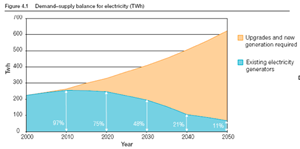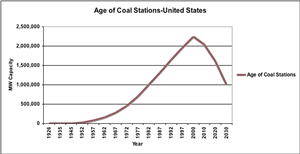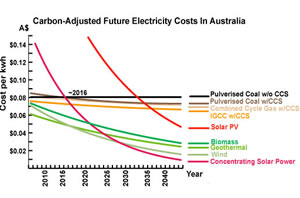 The looming replacement cycle of coal-fired powerApr 1, 2009 - Stewart Taggart - sciencealert.com.au A massive retirement of coal-fired power plants looms around the world. The resulting 'upgrade cycle' presents a once-in-a-generation opportunity to make real progress against climate change. Best of all, the opportunity is being offered on a silver platter. The real question is, what energy source will be ready to replace coal-fired power? Natural gas and renewables like wind, solar and geothermal are available now. By contrast, carbon capture and storage won't be available until well after 2020. By then the 'replacement cycle' will be largely over. Europe will be the first forced to choose a replacement,
its coal-fired power capacity is rapidly reaching
retirement age. An alternative will need to be found
quickly, as a steep decline in energy is set to occur
as plants are retired and replacements found. By 2020,
this replacement cycle will be nearly half-way over.
This hobbles latecomers looking to take over,like
carbon capture.
Australia is in much the same position. Starting
in 2010, much of the country's clapped-out coal-fired
plants will reach 40+ years of age. They will need
replacement and carbon capture won't be ready. Another
technology will have to be chosen. The only other
choice is to allow old, dirty plants to continue to
operate, but that could prove politically unpalatable.
The United States is a bit further back in the
replacement cycle. Even so, a huge number of coal-fired
plants there will start hitting 40 years of age in
2010.
Now, consider the potential replacements. Renewables are on a rapid downward price curve due to innovation, aggressive investment and rapidly-accumulating experience. Geothermal and wind energy are already cheaper than carbon capture and storage. Concentrating solar thermal power will be possible shortly. New price milestones are reached almost daily in solar photovoltaics. These cost-cuts are expected to continue, and even accelerate. That simply isn't the case with carbon capture. It's forecast to start off expensive and only slowly decline in price. This 'power of compounding' differential between
renewables and carbon capture presents a huge handicap
for coal as a cost-effective future energy source.
Every month that goes by these dynamics will become
more apparent, assuming the marketplace is allowed
to do its work free from interference of vested interests.
DESERTEC-Australia recommends Australia invest in replacing coal-fired plants with renewables backed up by natural gas between now and 2020. This will provide the lowest-cost, most reliable, most environmentally-friendly, most secure combination of technologies for meeting Australia's electricity needs during the medium-term. Should carbon capture arrive as promised, it can compete on merits. But Australia shouldn't wait on a unproven technology with continually receding timelines. Stewart Taggart is a director of Acquasol Infrastructure Ltd., a developer of environmentally-friendly power and water solutions building a municipal-scale solar desalination plant in South Australia's Upper Spencer Gulf. Stewart is also founder/administrator of DESERTEC-Australia, DESERTEC-USA and DESERTEC-China. DESERTEC promotes the concept of "Clean Power From Deserts." Editor's Note: Editor's Note: This opinion was provided by DESERTEC-Australia, please click here to sign up to their mailing list. This article is under copyright; permission must be sought from DESERTEC-Australia in order to reproduce it. Endorsements for DESERTEC: "It's time for Australia to begin a solar revolution,
a renewable energy revolution." "The new clean technologies like oxyfuels, carbon
capture and storage and IGCC (integrated gasification
combined cycle) are still unproven at scale." "(Clean coal) is a furphy, a pork pie to cover up
the fact that there is no such thing as clean coal,
"(The) first commercial plants fitted with CSS are
not expected for 10-15 years are likely to require
a carbon price of at least US$25-30 per ton of C02."
"A solar dish farm 100 miles by 100 miles in the
southwestern U.S. could provide as much electricity
as is needed to power the entire United States." Solar thermal can be the big gorilla on the grid.
We can supply over 90 per cent of Australia's generation
from this source on a continuing basis." One kilometer square of arid land can continuously
and indefinitely generate as much electricity as any
conventional 50 MW coal - or gas fired power station." "Solar thermal technology will be on the ground,
certainly in the United States and many other countries
long before so-called clean coal and nuclear power"
"The potential of the geothermal industry in Australia
is truly staggering ... It provides clean baseload power
and is potentially a very important contributor to
Australia's energy mix in a carbon-constrained world,"
Solar thermal technology provides a very plausible
path to providing renewable energy cheaper than coal."
"Concentrating solar power is a well-proven and demonstrated
technology, with over 100 years of accumulated operating
experience since 1984." "We believe that geothermal energy will play
an increasing role in securing the world's future
needs for clean energy." |



